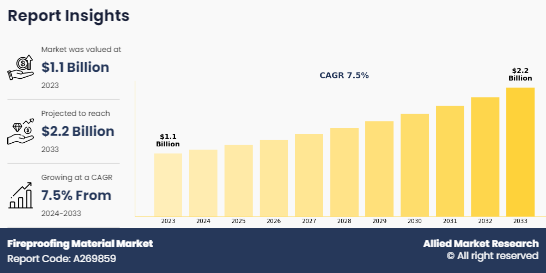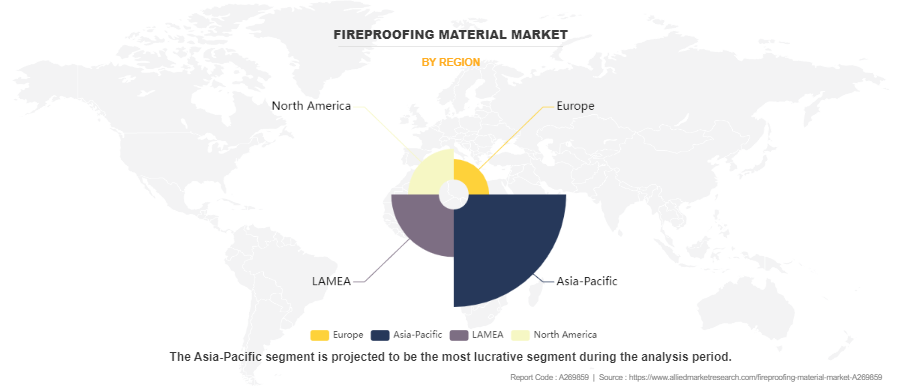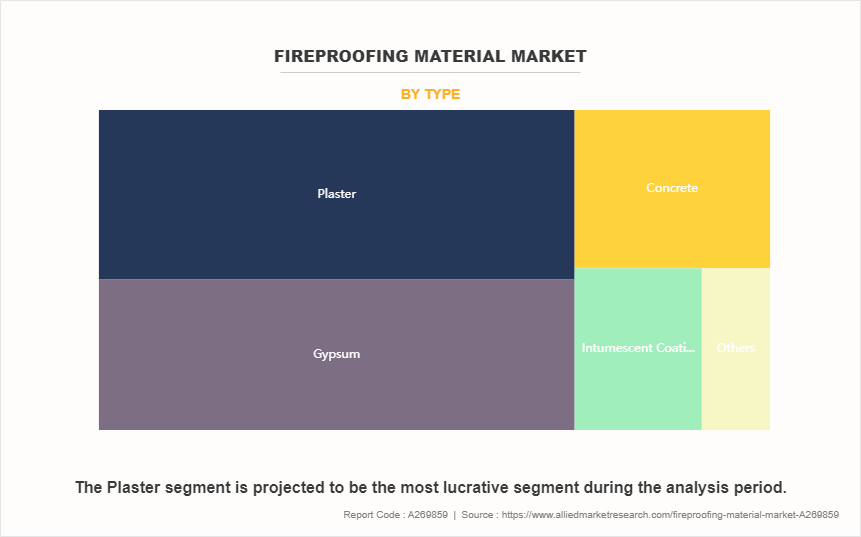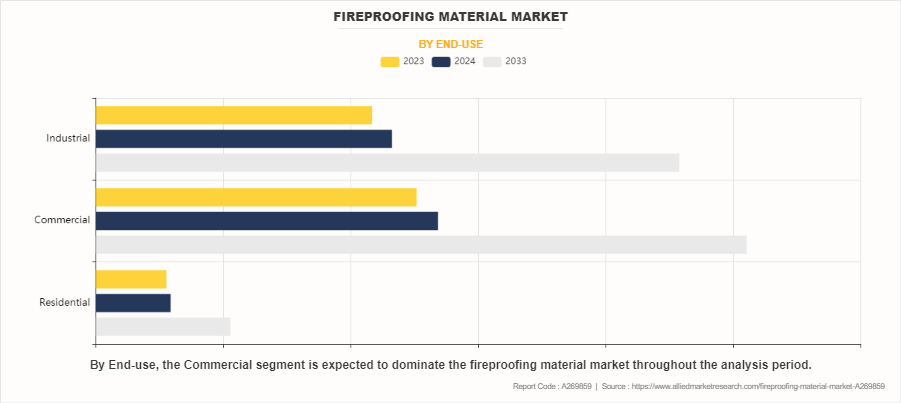Fireproofing Material Market Research, 2033
The global fireproofing material market size was valued at $1.1 billion in 2023, and is projected to reach $2.2 billion by 2033, growing at a CAGR of 7.5% from 2024 to 2033. The fireproofing materials market is driven by a combination of regulatory requirements, technological advancements, industry growth, and increasing awareness of fire safety and environmental sustainability. These drivers are expected to continue shaping the market and driving demand for innovative and effective fireproofing solutions in various sectors and applications.

Key Takeaways
- The key players in the Fireproofing Material market are PPG Industries, Inc, Akzo Nobel, Carboline, 3M, Rpm International Inc., Iris Coatings S.r.l, Knauf Insulation GmbH, BASF SE, Sika AG, and Sherwin-Williams Company.
- More than 6,765 product literatures, industry releases, annual reports, and other such documents of major industry participants along with authentic industry journals, trade associations' releases, and government websites have been reviewed for generating high-value industry insights.
- The segment analysis of each country in terms of value and volume during the forecast period 2023-2033 is covered in the global fireproofing material market report.
Introduction
Fireproofing materials are designed to resist or slow down the spread of fire and reduce the risk of structural damage, injury, and loss of life during a fire incident. These materials are used in various applications to enhance fire safety and protect buildings, infrastructure, and equipment from fire hazards.
Market Dynamics
Economic growth, rise in disposable incomes, and increased investment in real estate and infrastructure projects in emerging economies are driving the demand for fireproofing materials. Developing countries with growing construction and industrial sectors are significant contributors to the expansion of the global fireproofing materials market. The increasing frequency and intensity of natural disasters such as wildfires, earthquakes, and floods have heightened the awareness of fire safety and the importance of using fireproofing materials in disaster-prone regions. Governments, businesses, and communities are investing in fire-resistant construction materials to mitigate risks and enhance disaster resilience.
However, fireproofing materials, especially advanced and innovative solutions, can be expensive. High costs can deter customers, builders, and contractors from investing in fireproofing materials, particularly in regions with budget constraints or limited awareness of the long-term benefits of fire protection. Nevertheless, increasing investments in infrastructure projects, urbanization, and population growth is expected to offer lucrative fireproofing material market growth opportunities in the coming years.
Segments Overview
The fireproofing Material market is segmented on the basis of type, end use, and region. By type, it is categorized into concrete, plaster, gypsum, intumescent coatings, and others. By end use, it is categorized into residential, commercial, and industrial. Region-wise, the fireproofing material market share is studied across North America, Europe, Asia-Pacific, and LAMEA.

In 2023, the Asia-Pacific region commanded the highest market share in terms of revenue, accounting for approximately half of the global fireproofing material market revenue. This region is poised to maintain its dominant position throughout the forecast period, with a projected CAGR of 7.8% from 2023 to 2033. The Asia-Pacific region is currently experiencing rapid urbanization and a construction surge, particularly in key countries such as China, India, and Southeast Asian nations. The escalating construction activities across residential, commercial, and infrastructure sectors are fueling the demand for fireproofing materials. This demand is driven by the imperative to enhance fire safety measures and adhere to stringent building codes and regulations.

In 2023, the plaster segment dominated the global fireproofing material market, accounting for over one-third of the total market revenue. It is expected to maintain this leading position throughout the forecast period, with a projected CAGR of 6.9% from 2023 to 2033. Plaster fireproofing is a specialized fire protection technique that entails the application of plaster-based materials to structural components or surfaces to augment their fire resistance capabilities. This method significantly enhances the fire resistance of structural elements, thereby mitigating the risk of fire propagation and structural collapse during fire incidents.

Competitive Analysis
The major players operating in the global fireproofing material industry are PPG Industries, Inc, Akzo Nobel, Carboline, 3M, Rpm International Inc., Iris Coatings S.r.l, Knauf Insulation GmbH, BASF SE, Sika AG, and Sherwin-Williams Company.
Parent Market Overview
The parent market of the fireproofing materials market can be broadly categorized as the Construction and Building Materials Market. The construction and building materials market encompasses various sectors and products that are essential for building construction, renovation, and infrastructure development.
Rapid urbanization drives an escalating demand for housing, encompassing both residential and commercial sectors. This necessitates the construction of various housing structures, including apartment buildings, condominiums, townhouses, and other residential units. Additionally, the growing urban populations require the expansion and development of essential infrastructure such as roads, bridges, tunnels, airports, and public transportation systems to enhance mobility and connectivity.
Furthermore, urbanization fosters the establishment of more businesses, offices, retail spaces, and entertainment venues, leading to the construction of commercial buildings. Moreover, as urban populations continue to grow, there is an increasing demand for essential public amenities, including schools, healthcare facilities, government offices, and recreational centers. This results in a rise in the construction of public and civic buildings to meet the diverse needs of urban residents.
Moreover, as per Invest India, the construction sector in India is projected to achieve a market value of $1.4 trillion by 2025. By 2030, it is anticipated that cities will contribute to 70% of India's GDP. The construction market in India encompasses 250 sub-sectors with interconnected links across various industries. Through the National Infrastructure Pipeline (NIP), India has allocated an investment budget of $1.4 trillion for infrastructure development, with 24% earmarked for renewable energy, 18% for roads and highways, 17% for urban infrastructure, and 12% for railways.
Key Benefits For Stakeholders
- This report provides a quantitative analysis of the market segments, current trends, estimations, and dynamics of the fireproofing material market analysis from 2023 to 2033 to identify the prevailing fireproofing material market opportunities.
- The market research is offered along with information related to key drivers, restraints, and opportunities.
- Porter's five forces analysis highlights the potency of buyers and suppliers to enable stakeholders make profit-oriented business decisions and strengthen their supplier-buyer network.
- In-depth analysis of the fireproofing material market segmentation assists to determine the prevailing market opportunities.
- Major countries in each region are mapped according to their revenue contribution to the global market.
- Market player positioning facilitates benchmarking and provides a clear understanding of the present position of the market players.
- The report includes the analysis of the regional as well as global fireproofing material market trends, key players, market segments, application areas, and market growth strategies.
Fireproofing Material Market Report Highlights
| Aspects | Details |
| Market Size By 2033 | USD 2.2 billion |
| Growth Rate | CAGR of 7.5% |
| Forecast period | 2023 - 2033 |
| Report Pages | 250 |
| By Type |
|
| By End-use |
|
| By Region |
|
| Key Market Players | The Sherwin-Williams Company, Iris Coatings S.r.l, 3M, PPG INDUSTRIES, INC, Knauf Insulation GmbH, Sika AG, Carboline Company, RPM International Inc., BASF SE, Akzo Nobel N.V |
Analyst Review
According to the insights of the CXOs of leading companies, the fireproofing materials market is driven by increased awareness of building safety codes and regulations, especially in high-rise buildings, public infrastructures, and industrial facilities, has driven the demand for fireproofing materials. Governments and regulatory bodies worldwide are enforcing stricter fire safety standards, which mandate the use of fire-resistant materials in construction and renovation projects. In addition, growing awareness among consumers, businesses, and industries about the importance of fire safety has increased the demand for fireproofing materials. High-profile fire incidents and disasters have highlighted the critical need for effective fire protection measures, thus driving the adoption of fireproofing solutions.
Moreover, rapid urbanization, population growth, and increase in investments in infrastructure projects have fueled the demand for fireproofing materials. As construction activities expand globally, there is a growing need for fire-resistant materials to enhance the safety and durability of buildings and structures. Besides, ongoing research and development efforts in the field of fireproofing materials have led to the introduction of innovative products with improved fire resistance, durability, and performance characteristics. Technological advancements are driving the market towards more efficient and sustainable fireproofing solutions.
Asia-Pacific is the largest regional market for Fireproofing Material.
The major players operating in the global fireproofing material market are PPG Industries, Inc, Akzo Nobel, Carboline, 3M, Rpm International Inc., Iris Coatings S.r.l, Knauf Insulation GmbH, BASF SE, Sika AG, and Sherwin-Williams Company.
Growing awareness among consumers, businesses, and industries about the importance of fire safety has increased the demand for fireproofing materials.
Commercial is the leading end-user of Fireproofing Material Market.
The fireproofing material market was valued at $1.1 billion in 2023, and is estimated to reach $2.2 billion by 2033, growing at a CAGR of 7.5% from 2024 to 2033.
Loading Table Of Content...
Loading Research Methodology...



